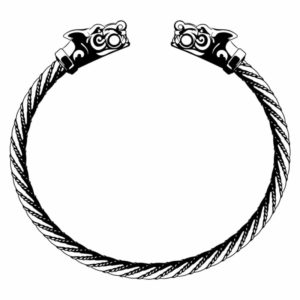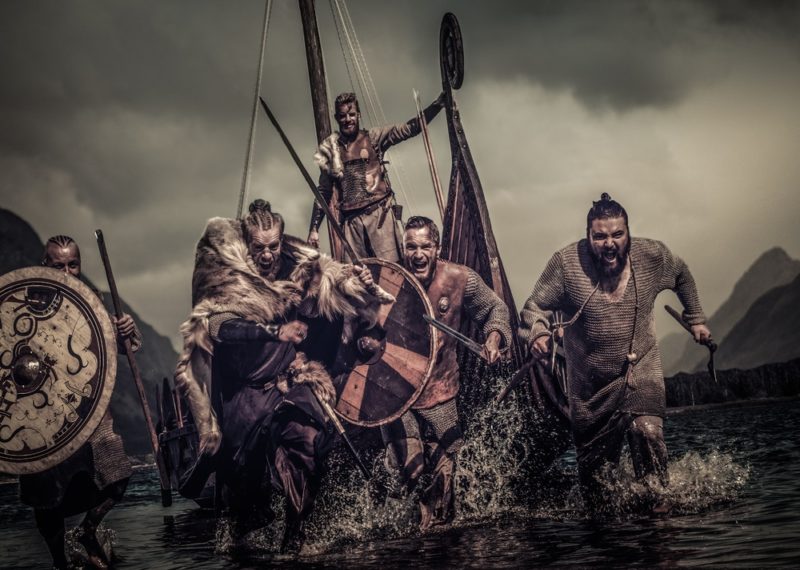Despite their hardships, Vikings made a name for themselves in the history books. Because of the brutal raids the Viking people often conducted, people all over the world held the Vikings in high regard. While most people picture the Norse as brutish people, their attention to detail and the pride they took in making exquisite jewelry create a stark contrast.
Since their civilization began, the Vikings manufactured jewelry. They were experts in this field and could make jewelry that was made from metals and ornate items with incredible fine craftsmanship. When we consider the fact that Viking jewelry was created almost 1000 years ago, we can see that the Vikings were unrivaled when it came to jewelry-making.
The arm ring is a fascinating piece of jewelry, so if you are hoping to find out more, here is everything you need to know about Viking armrings.
Arm Rings in the Viking Age
It is no secret that the Norse were interested in circular or ring-shaped jewelry. These ring-shaped items were worn by women and men on their wrists, forearms, fingers, and sometimes even around their necks. Simple circlets made up several rings, while others were elaborate masterpieces.
Depending on the user’s wealth, these bracelets or armrings were made of gold, silver, iron, bronze, or other such metals. Wearing expensive armrings was a display of wealth, often worn as a type of wearable currency, and reinforced the person’s status in the Viking honor system.
An arm ring was worn on the arm and not typically on the wrist, the way we wear bracelets today. Instead, these jewelry pieces were worn on the upper arm around the bicep.
What Did the Norse Use Viking Arm Rings for?
These bracelets had two primary functions in Nordic culture. These were decorative and commercial functions.
Commercial Use
The bracelets that were used for payment purposes were not particularly attractive. It was uncommon to find details etched onto these bands. They were, however, extremely valuable and, more significantly, functional.
It was convenient just to rip off a section of the band and use it to pay for things. During the Viking Age, practically every man wore a band designed for commerce that was long enough to encircle most of the arm.
Silver was the resource most commonly used to construct bracelets that were purely intended to be used as a payment method.
Decorative or Aesthetic Use
These items often featured a variety of embellishments and motifs and were typically used as everyday adornments. Bronze and silver were the most popular metals for constructing bracelets. Gold was greatly regarded during the Viking era, but only the wealthiest could acquire it.
The bands that the Norse donned as jewelry were commonly referred to as arm rings since they resembled rings but were tailored to the size of the wearer’s wrist. Armrings contributed considerably to the formidable Viking style with their exquisite design, ornate patterns, and engraved animal figurines.
Oath Rings
During the Bronze Age and early Viking Age, oath rings were widely used. The consequences of a broken promise came considerably faster because those that proved unreliable were deemed unworthy of society’s concern.
Breaking your vow meant betraying your own honor and invalidating your dignity. The Norse Sagas are full of tales of women and men who kept their promises even when it cost them their very lives, and there are numerous accounts of this in Viking history.
A spoken word was deemed sufficient in most circumstances, but an oath may be enhanced by affixing it to sacred objects. As a result, Vikings were free to make their pledge by swearing on their gods.
More typically, a Viking might swear by his or her weaponry, meaning that if their word failed, so would their weapons. Vikings would swear on an oath ring or other important jewelry from time to time.
Not All Armrings Were Oath Rings
Oath rings are well-documented in literature and history, and archaeology backs them up. This doesn’t, however, imply that all armrings were used as oath rings. In reality, the majority of arm rings discovered by archaeologists were from the Viking Age.
The truth is that these neck torques and armrings were used in Europe for centuries and were more widespread during the Bronze Age (approximately 3100 to 300 B.C.) than they were during the Viking Age.
Vikings didn’t wear an oath ring to have something to swear on, but rather the Vikings wore arm rings because they had pledged oaths. The Viking warrior often pledged his allegiance to his lord, who was obligated to reward such a pledge with wealth and favor.
Armrings in Rituals
Young male Vikings often had essential duties to perform in their societies because of the exceedingly tough living conditions and the absence of men from the household. Boys, therefore, played a significant role in Viking civilization as future warriors, rulers, and guardians of their villages.
When a boy matured into a man, he was given an armring as a present. In Viking society, the act of distributing armrings to young men was a significant ceremony. The boy was no longer there, and in his stead stood a man free to join his siblings in their quest for wealth and fame.

Final Thoughts
Armrings played a significant role in Nordic society. They were a symbol of loyalty and honor, had commercial and decorative purposes, and were also used in ceremonial rituals. These items are still sought after by people around the world today and are made from several materials, just as they were during the Viking era.
Frequently Asked Questions
Below, we answer some of the most commonly asked questions about Viking armrings.
1. Did These Bracelets Have Sentimental Value?
The Vikings were seafaring, which means that they would often spend months at a time traveling to new lands. This is why they frequently produced armrings with specific marks and engraved embellishments for their spouses as a token of love.
These Viking armrings, which were presented to the women as a gift, were a secret gesture between the couples. This was a gesture in which the man requested the woman to remain true to him until he was reunited with her. It’s apparent that these bracelets held a lot of emotional weight for the ancient Nordics.
2. What Materials Were Used to Make an Arm Ring?
The world was a different place during the Viking era, and not every person could afford precious metals like silver or gold. This is why the Vikings used a range of materials to produce arm rings.
These include gold, silver, iron, bronze, copper, and even animal bones. The materials your bracelets were made from were dependent on the amount of money you were willing to spend.
3. Are Arm Rings Still Worn Today?
Yes, people around the world still wear Viking arm rings today. There are several manufacturers that make these bracelets as a symbol of Viking heritage and in celebration of the bravery and loyalty that the Norse displayed.
If you are interested in buying Viking bracelets, you can find several online stores that sell intricately designed pieces made from silver, gold, and other metals. Many of these stores offer discounts, too, so be sure to look for seasonal sales and discount code offers.



